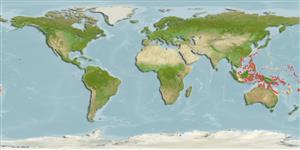>
Gobiiformes (Gobies) >
Gobiidae (Gobies) > Gobiinae
Etymology: Trimmatom: Greek, trimma, -atos = something crushed + Greek, tomos = cut (Ref. 45335).
More on author: Winterbottom.
Environment: milieu / climate zone / depth range / distribution range
Ecología
marino asociado a arrecife; rango de profundidad 0 - 20 m (Ref. 90102). Tropical
Western Pacific: Taiwan, Philippines, Australia.
Tamaño / Peso / Age
Maturity: Lm ? range ? - ? cm
Max length : 1.6 cm TL macho / no sexado; (Ref. 90102)
Short description
Claves de identificación | Morfología | Morfometría
Espinas dorsales (total) : 6 - 7; Radios blandos dorsales (total) : 8 - 9; Espinas anales: 1; Radios blandos anales: 8 - 9. Characterized by semi-translucent yellowish body color; white dorsally on head and nape; presence of five diffuse, internal brownish bars on side of body from level of first dorsal fin to caudal peduncle; short brown saddles sometimes evident along back; median fins orange with broad white margins; sometimes with elongate first dorsal spine, all soft dorsal rays unbranched; very elongate fourth pelvic ray; unbranched fifth pelvic ray, 15% length of fourth pelvic ray; lateral scale series 23; cheek and opercle without scales; depth of body 4.9-5.6 in SL (Ref. 90102).
Inhabits reef crevices in 0-20 m (Ref. 90102).
Life cycle and mating behavior
Madurez | Reproducción | Puesta | Huevos | Fecundidad | Larva
Randall, J.E. and K.K.P. Lim (eds.), 2000. A checklist of the fishes of the South China Sea. Raffles Bull. Zool. Suppl. (8):569-667. (Ref. 36648)
IUCN Red List Status (Ref. 130435: Version 2024-1)
Threat to humans
Harmless
Human uses
Pesquerías: sin interés
Herramientas
Special reports
Download XML
Fuentes de Internet
Estimates based on models
Preferred temperature (Ref.
123201): 25.9 - 29.4, mean 28.6 °C (based on 1289 cells).
Phylogenetic diversity index (Ref.
82804): PD
50 = 0.5078 [Uniqueness, from 0.5 = low to 2.0 = high].
Bayesian length-weight: a=0.00724 (0.00339 - 0.01546), b=3.10 (2.92 - 3.28), in cm total length, based on LWR estimates for this (Sub)family-body shape (Ref.
93245).
Nivel trófico (Ref.
69278): 3.0 ±0.3 se; based on size and trophs of closest relatives
Resiliencia (Ref.
120179): Alto, población duplicada en un tiempo mínimo inferior a 15 meses (Preliminary K or Fecundity.).
Fishing Vulnerability (Ref.
59153): Low vulnerability (10 of 100).
